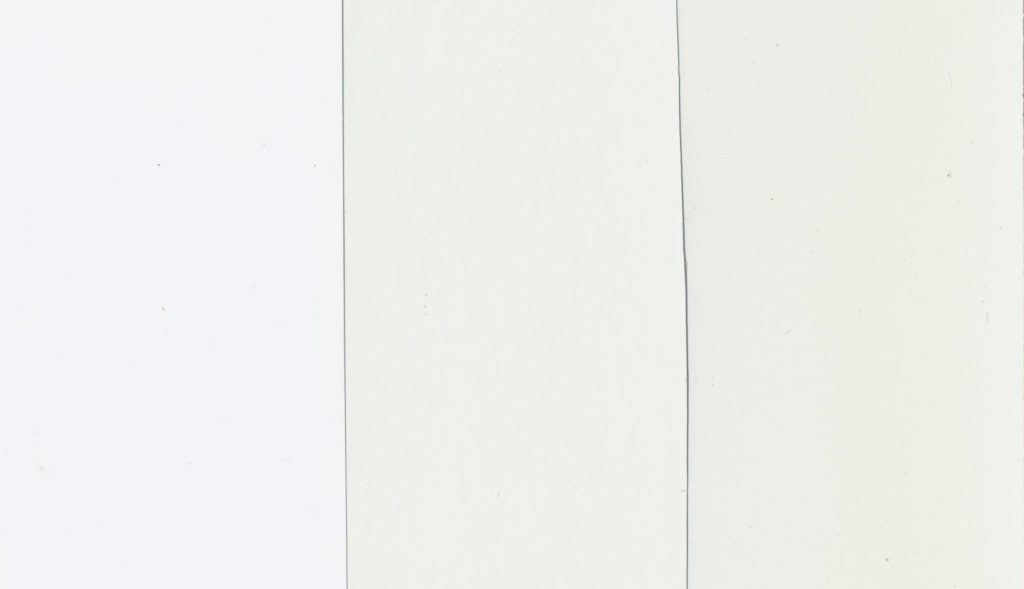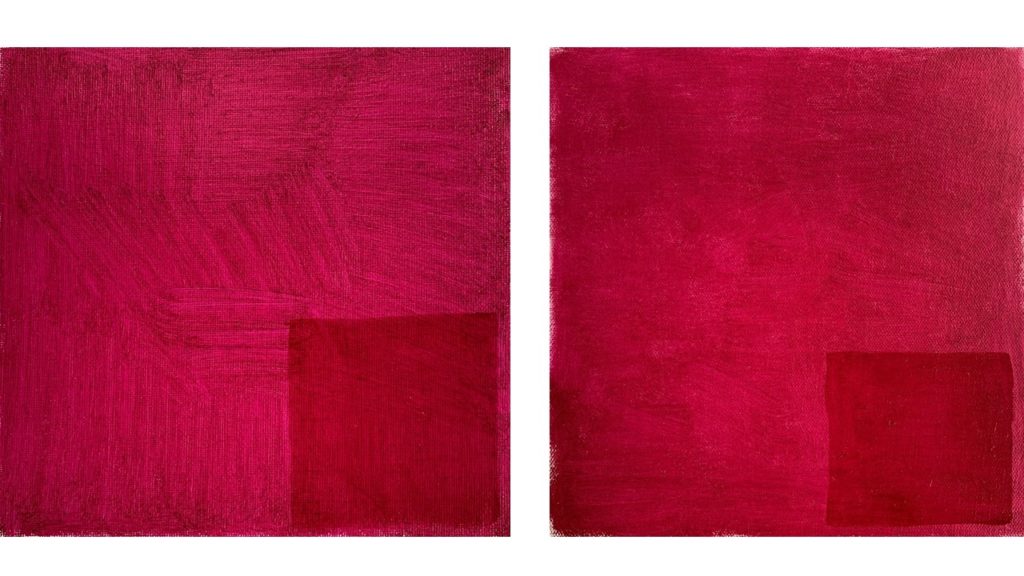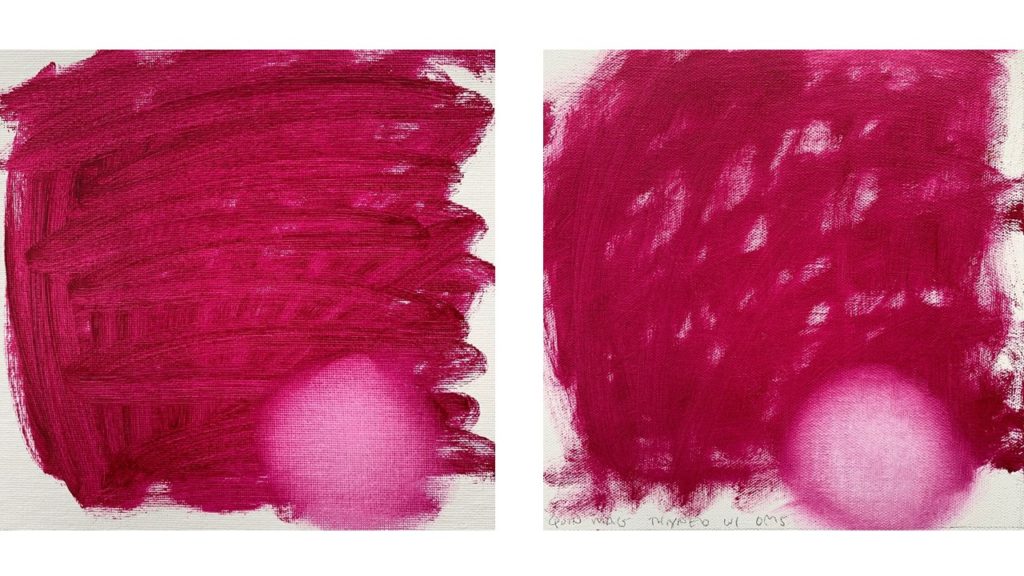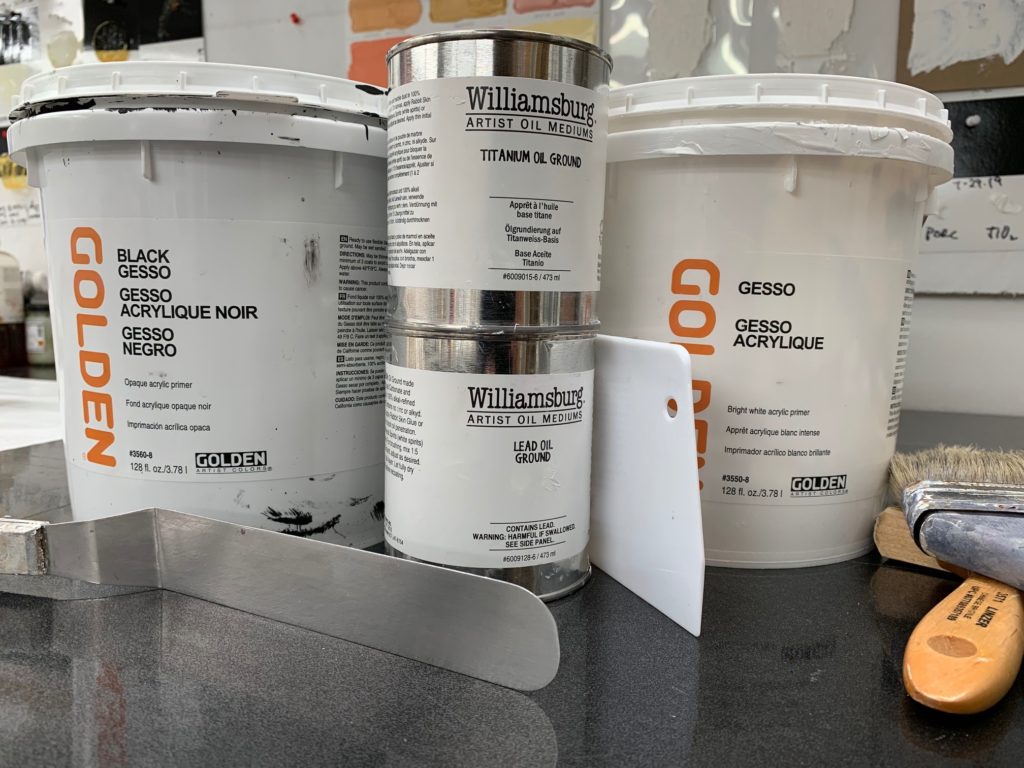EDITOR’S NOTE (4/14/21): Please note our recommendation for sizing before applying Oil Ground is currently being retested and this article has been changed to reflect this development.
Grounds are selected to provide the proper color, level of absorbency and tooth to meet an artist’s needs. Oil painters have the extra concern of protecting from oil penetration into the substrate, which can mean more coats, and often additional time spent in preparation. This article looks at a couple of our popular grounds for oil painters and points out some of the basic characteristics and differences between GOLDEN Acrylic Gesso, Williamsburg Titanium Oil Ground and Williamsburg Lead Oil Ground.
Preparation
The first thing to consider is how much time you are willing to spend preparing the surface and waiting to start your painting. One of the virtues of Acrylic Gesso, is that it is a single product and is ready for paint in a couple days. If you are eager to get painting, Gesso is the best option for you! It comes in white and black and can be mixed to any shade of gray desired, or tinted with acrylic paint to create a toned ground. Gesso can be applied with a brush or trowel and can be thinned with water up to 25%. It can be layered once it is touch dry, so multiple layers can be applied in a single day. Three coats should be sufficient to protect the natural fibers in canvas, linen or paper from the degrading effects of oil paint or oil ground. After the final layer, we recommend waiting 3 days for the acrylic to fully dry before painting on top with oils. Oil paint can be applied directly onto acrylic gesso.
Oil Ground takes a little longer to prepare. This is because natural fiber substrates or panel first need 2-3 layers of sizing before applying the Oil Ground. Any number of products can be used as a size – rabbit skin glue or Gesso, just to name a few. These layers should be allowed to fully dry before applying Williamsburg Oil Ground. Once applied, the first layer of ground should be touch dry in 1 – 2 days, after which time additional layers can be applied. Usually two layers are sufficient, but any number can be applied to suit your preference. Once the final layer is applied, we recommend 1-2 weeks for the ground to go through the most active part of the drying process before starting your painting on top. This is best achieved in a warm, well-lit environment. Oil Ground can be applied directly from the container with a knife or trowel, or thinned with mineral spirits or turpentine for brush application. Undiluted Oil Ground does not shrink upon drying, like Gesso does, so can easily fill the weave of fabric surfaces or build a dense film with just a couple layers. Click HERE for written application directions of Williamsburg Oil Ground.
Color

The color of the ground can contribute to vibrancy of the painted layers. Acrylic Gesso is brighter white and cooler than either of the oil grounds and does not change over time. Thin, translucent oil colors applied over white Acrylic Gesso are noticeably more vibrant than the same color over Oil Ground. Both Titanium and Lead Oil Ground are slightly off-white when freshly applied, but settle to a muted tone after several years, especially if stored in darkness or low light, such as in the image above. This is important to consider if the ground is left exposed in a painting, as time will impact the color.
Feel
Acrylic Gesso and both Oil Grounds are fairly matte in appearance, especially when troweled onto the surface. Brushed applications tend to have slightly more sheen. In terms of feel, they are not dramatically different from one another, but they are unique in subtle ways that is mostly experienced during application of the first layer of paint. Acrylic Gesso is a little more slick than the oil grounds. This quality allows the brush to slip over the surface for faster mark making or gestural type painting. The brush can still chatter across the surface when it’s dry, but as paint builds on the acrylic surface, the oil paint can slip around and expose the luminosity provided by the gesso. The oil ground feels drier and toothier than acrylic gesso and provides more brush drag. This seems to pull the paint from the brush and beds the material into the surface more easily.
We assumed because the Acrylic Gesso feels less absorbent than the Oil Ground, that it would be easier to wipe off wet paint. But, that was not necessarily the case with this test. In the majority of our samples, the acrylic gesso stained about the same, or more, than the oil ground. Fresh oil ground applications, dried for several weeks to a couple months, stained about the same as the gesso, where older oil ground samples allowed us to wipe back to the ground without much staining at all. As the oil ground cures over time, the surface becomes tighter and less absorbent than a younger film. The lower right corners of image 3, shows it was a little easier to wipe back to the white of the oil ground than on the acrylic gesso. That said, the white of both grounds could be regained with a little mineral spirits or oil on the wiping cloth.


In the end, these grounds are not extremely different from one another. In fact, when testing these grounds next to one another, applying straight paint, washes or oily layers onto the surface, our ability to differentiate them was challenged. Their qualities are more intuitively experienced than physically felt. Their differences lie in preparation, their color, and the subtlety of how the brush feels on the surface. Like a lot of the materials used in oil painting, ground preferences ultimately depend on a combination of factors. The amount of time one is willing to invest in a surface, the artist’s technique, their relationship to the different grounds, whether personal or historical, all influence that decision. We encourage oil painters to try these grounds to see for themselves the differences and similarities between these materials and how a ground can influence the painting experience and final look of the artwork.
If you have any questions about these materials or their application, please do not hesitate to contact us at [email protected] or by calling 800-959-6543.
About Greg Watson
View all posts by Greg Watson -->Subscribe
Subscribe to the newsletter today!


Thank you for this useful article. I spoke to Greg at Golden a few weeks ago regarding Williamsburg Oil Ground and how to use it. He was so knowledgeable and helpful. I paint in oils and am investigating Old Master techniques. I like the Williamsburg paints for their clarity and tooth.
To limit the slippery surface of acrylic gesso, I add a small amount of fine ground pumice to the gesso. Adds tooth that helps grab the oil paint similarly to an oil ground.
Hello again Joanne,
We also have Pastel Ground and Fine Pumice Gel which both provide a slightly abrasive surface. They can be applied over the Gesso or added to it in any amount. Painting with oils is fine on these products. When adding powdered solids to our Gesso we would recommend keeping the additions below 10%, as the solids level in the gesso is already pretty high. Overloading the solids can lead to a less flexible film.
Thanks!
Greg
A good quality professional level acrylic gesso is easier to oil paint on than some of the cheaper acrylic gessos which sometimes feel like painting on a slippery tile floor.
Hi Joanne,
Thanks for the comment. GOLDEN Acrylic Gesso is well balanced with good tooth and absorbency. It is a pleasure to paint on with oils!
Greg
Is there any Zinc oxide in your acrylic gesso?
Hello Mark,
Thanks for asking. No, we do not include any Zinc Oxide, only Titanium Dioxide and Calcium Carbonate. Here is the Product Information Sheet for our White and Black Gesso: https://www.goldenpaints.com/technicalinfo/technicalinfo_gesso
Greg
Yo Greg, keep up the good work! Just ordered some lead oil ground. Can’t wait to try it out.
Hope you are well.
Max Decker
Hi Max!
That’s great! Hope you enjoy it for painting some beautiful landscapes!
Greg
Hi, the paint on acrylic gesso looks nice. How do they compare against sinking in? I have double primed (acrylic) canvas and thinking of adding a layer of Golden gesso on top to reduce potential for sinking in, followed by an imprimatura containing some stand oil
Hi Bob,
Sorry for the late reply! Adding a coat of Acrylic Gesso over a pre-primed surface is always a good idea. We recommend wiping down the canvas first with a damp cloth and letting it dry. There can be some sinking in over Acrylic Gesso, but the imprematura with stand should help reduce that potential. Perhaps you can include some faster drying pigments in there. We haven’t really tested drying times for an imprematura before additional layers are added, but would think giving it some time to dry before painting over top would be good, perhaps a week or two after touch dry.
Hope it goes well!
Greg
Greetings Greg.
I have a few questions about ‘lead oil ground’.
Does it contain any solvents, driers/siccatives? Or is it just simply oil and pigment? Does it have more lead pigment or marble dust?
Could I mix small amount of ‘lead oil ground’ with regular titianium white oil paint and then use it as normal oil paint? Or is this suitable only for priming?
Thank you very much and best wishes.
Thank you for your questions Vytas. The Lead Oil Ground does not contain any solvent, but there is a very small amount of cobalt Manganese drier to help it start the drying process. It also has a percentage of marble dust (less than lead) and Titanium Dioxide pigment. The marble dust is to provide tooth and the TiO2 is to help provide a brighter white look. Even with the Titanium, because of the translucency of the lead and marble dust not being able to cover the yellow of the oil completely, this product can take on a yellowish look when dark yellowing settles in. For that reason, it is not recommended as a white alternative in the upper layers of the work. But, it should be structurally stable if a small amount is added to your color. This formulation is ideal as a ground. Flake White is preferable as a brighter white in the upper layers if lead is desired in those layers.
Thanks
Greg